A-26 Invader
- See also Martin B-26 Marauder
| A-26 Invader | |
|---|---|
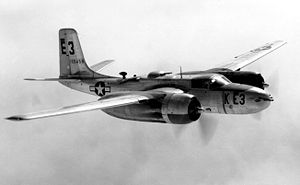 |
|
| USAAF A-26B-35-DL (AAF Ser. No. 41-39456) | |
| Role | Light bomber |
| Manufacturer | Douglas Aircraft Company |
| First flight | 10 July 1942 |
| Retired | 1972 |
| Primary users | United States Army Air Forces United States Air Force United States Navy French Air Force |
| Number built | 2452[1] |
| Unit cost | US$242,595[2] |
| Variants | On Mark Executive, Marketeer, and Marksman |
The Douglas A-26 Invader (B-26 between 1948-1965) was a United States twin-engined light attack bomber built by the Douglas Aircraft Co. during World War II that also saw service during several of the Cold War's major conflicts. A limited number of highly modified aircraft served in combat until 1969. The last A-26 was retired from military service in 1972 by the National Guard Bureau and donated to the National Air and Space Museum.
Contents |
Design and development
The A-26 was an unusual design for an attack bomber of the early 1940s period, as it was designed as a single-pilot aircraft (sharing this characteristic with the RAF's de Havilland Mosquito, among others). The aircraft was designed by Edward Heinemann, Robert Donovan and Ted R. Smith.[3]
The Douglas XA-26 prototype (41-19504) first flew on 10 July 1942 at Mines Field, El Segundo, with test pilot Benny Howard at the controls. Flight tests revealed excellent performance and handling, but there were problems with engine cooling which led to cowling changes and omission of the propeller spinners on production aircraft, plus modification of the nose landing gear after repeated collapses during testing.[4]
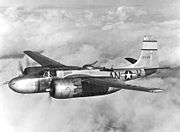
The A-26 was originally built in two different configurations. The A-26B had a "solid" nose, which normally housed six (or later eight) .50 caliber machine guns, officially termed the "all-purpose nose", later commonly known as the "six-gun nose" or "eight-gun nose". The A-26C’s "glass" nose, officially termed the "Bombardier nose", contained a Norden bombsight for medium altitude precision bombing. The A-26C nose section included two fixed M-2 guns, later replaced physically and functionally by underwing gun packs or internal guns in the wings.
After about 1,570 production aircraft, three guns were installed in each wing, coinciding with the introduction of the "eight-gun nose" for A-26Bs, giving some configurations as many as 14 .50 caliber machine guns in a fixed forward mount. An A-26C nose section could be exchanged for an A-26B nose section, or vice versa, in a few man-hours, thus physically (and officially) changing the designation and operational role. The "flat-topped" canopy was changed in late 1944 after about 820 production aircraft, to a clamshell style with greatly improved visibility.[5][6]
Alongside the pilot in an A-26B, a crew member typically served as navigator and gun loader for the pilot-operated nose guns. In an A-26C, that crew member served as navigator and bombardier, and relocated to the nose section for the bombing phase of an operation. A small number of A-26Cs were fitted with dual flight controls, some parts of which could be disabled in flight to allow limited access to the nose section. A tractor-style "jump seat" was located behind the "navigator's seat." In most missions, a third crew member in the rear gunner's compartment operated the remotely-controlled dorsal and ventral gun turrets, with access to and from the cockpit only possible via the bomb bay when that was empty.[7]
Operational history
World War II

The Douglas company began delivering the production model A-26B in August 1943. Invaders first saw action with the Fifth Air Force in the Southwest Pacific theater on 23 June 1944, when they bombed Japanese-held islands near Manokwari.[8]
They began arriving in Europe in September 1944 for assignment to the Ninth Air Force, and entered combat two months later on 19 November.
Postwar era
The USAF Strategic Air Command had the B-26 (RB-26) in service from 1949 through 1950, the Tactical Air Command through the late 1960s, and the last examples in service with the Air National Guard through 1972. The US Navy also used a small number of these aircraft in their utility squadrons for target towing and general utility use until superseded by the DC-130A variant of the C-130 Hercules . The Navy designation was JD-1 and JD-1D until 1962, when the JD-1 was redesignated UB-26J and the JD-1D was redesignated DB-26J.

Korean War

B-26 Invaders of the 3d Bombardment Group, operating from bases in Southern Japan, were some of the first USAF aircraft engaged in the Korean War, carrying out missions over South Korea on 27 and 28 June, before carriying out the first USAF bombing mission on North Korea on 29 June 1950 when they bombed an airfield outside of Pyongyang.[9] B-26s were credited with the destruction of 38,500 vehicles, 406 locomotives, 3,700 railway trucks, and seven enemy aircraft on the ground. On 14 September 1951, Captain John S. Walmsley, Jr. attacked a supply train. When his guns jammed, he illuminated the target with his searchlight to enable his wingmen to destroy the train. Walmsley was shot down and posthumously awarded the Medal of Honor. Invaders carried out the last USAF bombing mission of the war 24 minutes before the cease fire was signed on 27 June 1953.[10][11]
First Indochina War

In the 1950s, the French Air Force's (Armée de l'Air) Bombing Groups (Groupe de Bombardement) including GB 1/19 Gascogne and GB 1/25 Tunisia used USAF-lent B-26 during the First Indochina War.[12]
Cat Bi (Haiphong) based Douglas B-26 Invaders operated over Dien Bien Phu in March and April 1954 during the siege of Dien Bien Phu. In this period a massive use of Philippines based USAF B-26s against the Viet Minh heavy artillery was planned by the U.S. and French Joint Chief of Staff as for Operation Vulture, but it was eventually cancelled by the respective governments.
Service with the USAF in Southeast Asia
The first B-26s to arrive in Southeast Asia were deployed to Takhli RTAFB, Thailand in December 1960. These unmarked aircraft, operated under the auspices of the U.S. CIA (Central Intelligence Agency), were soon augmented by an additional 16 aircraft, 12 B-26Bs and B-26Cs plus 4 RB-26Cs under Operation Mill Pond. The mission of all of these aircraft was to assist the Royal Lao Government in fighting the Pathet Lao. The repercussions from the Bay of Pigs invasion meant that no combat missions are known to have been flown, though RB-26Cs operated over Laos until the end of 1961. The aircraft were subsequently operated in South Vietnam under Project Farm Gate.[13] The only other deployment of B-26 aircraft to Laos prior to the introduction of the B-26K/A-26A, was the deployment of two RB-26C aircraft, specifically modified for night reconnaissance, deployed to Laos between May and July 1962 under Project Black Watch. These aircraft, initially drawn from Farm Gate stocks, were returned upon the end of these missions.[14]
The aircraft from Laos participated in the early phase of the Vietnam War with the USAF, but with Vietnamese markings as part of Project Farm Gate. Though Farm Gate operated B-26Bs, B-26Cs, and genuine RB-26Cs, many of these aircraft were operated under the designation RB-26C, though they were used in a combat capacity.[15] During 1963, two RB-26C were sent to Clark AB in the Philippines for modifications, though not with night systems as with those modified for Black Watch. The two aircraft returned from Black Watch to Farm gate were subsequently given the designation RB-26L to distinguish them from other modified RB-26C, and were assigned to Project Sweet Sue.[14] Farm Gate's B-26s operated alongside the other primary strike aircraft of the time, the T-28 Trojan, before both aircraft types were replaced by the A-1 Skyraider.[16] The B-26s were withdrawn from service in 1964 after two accidents related to wing spar fatigue.
In response to this, the On Mark Engineering Company of Van Nuys, California was selected by the Air Force to extensively upgrade the Invader for a counterinsurgency role. The first production flight of the B-26K was on May 30, 1964 at the Van Nuys Airport. On Mark converted 40 Invaders to the new B-26K Counter-Invader standard, which included upgraded engines, propellers, and brakes, re-manufactured wings, and wing tip fuel tanks, for use by the 1st Air Commando Group. In May 1966, the B-26K was re-designated A-26A for political reasons and deployed in Thailand to help disrupt supplies moving along the Ho Chi Minh trail. Two of these aircraft were further modified with a Forward Looking Infrared (FLIR system) under project Lonesome Tiger, as a part of Operation Shed Light.[17]
Bay of Pigs Invasion
In April 1961, B-26s provided from U.S. military stocks were flown by Cuban exiles and CIA contract aircrews during the failed Bay of Pigs invasion. [18]
The CIA-backed Bay of Pigs invasion of Cuba was preceded by air attacks by B-26 bombers launched from Nicaragua and painted in the scheme of the Cuban Air Force. Their objective was to destroy Fidel Castro's air force, mostly armed T-33 jet trainers provided to the Batista regime by the United States, on the ground. During April 15-16, 1961, B-26 raids met with mixed success in that they did not destroy most of the T-33 force, and one wave of B-26's was mauled by Castro's jets. Planned follow-up raids were cancelled after at least one American pilot, a member of the Alabama Air National Guard, was killed, assuring Castro of air superiority over the beach head. While the Invaders failed to achieve their objective, their force was too small to accomplish it in less than three air raids, and after the first the element of surprise was lost.[19][20]
Africa in the 1960s
CIA mercenary pilots, some previously employed during the Bay of Pigs Invasion, flew B-26Ks for ground attack against Simba rebels in the Congo Crisis. New production B-26K Counter-Invaders were delivered to the Congo via Hurlburt Field in 1964.[6].
The Portuguese Air Force purchased Invaders covertly for use in Angola in 1965.[21]
Biafra used two provisionally armed B-26s in combat during Nigerian Civil War in 1967, flown among others by Jan Zumbach.
Variants
Douglas/US Military Variants
The large majority of the A-26/B-26 Invader's production run of 2,452 were early A-26Bs and A-26Cs.
- XA-26
- Serial no. 41-19504 served as the prototype for the series; initially flown with dummy armament
- XA-26A
- Serial no. 41-19505 served as a prototype night fighter with a crew of two - pilot plus radar-operator/gunner
- XA-26B
- Serial no. 41-19588 was a prototype "solid-nosed" attack variant with crew of three: pilot, gun loader/navigator (in front cockpit) plus gunner in rear, and carrying a forward firing 75-mm cannon.[22]
- A-26B
- Attack bomber with solid nose carrying six or eight 0.50 in machine guns. Production totals: 1,355 A-26Bs were built and delivered, 205 at Tulsa, Oklahoma (A-26B-5-DT to A-26B-25-DT) plus 1,150 at Long Beach, California (A-26B-1-DL to A-26B-66-DL). About 24 more airframes were built at Long Beach but not delivered to USAAF, some of those later sold to other civil and military customers. A-26B was redesignated B-26B with USAF in 1948.[23]
- TB-26B
- Unarmed variant converted from B-26B for training purposes.
- VB-26B
- Unarmed variant converted from B-26B for administrative purposes.
- A-26C
- Attack bomber. Production totals: 1,091 A-26Cs were built and delivered, five at Long Beach, California (A-26C-1-DL and A-26C-2-DL) plus 1,086 at Tulsa, Oklahoma (A-26C-16-DT to A-26B-55-DT). About 53 more airframes were built at Tulsa but not delivered to USAAF, some of those later sold to other civil and military customers. A-26C was redesignated B-26C with USAF in 1948.[24]
- RB-26C
- Unarmed photo reconnaissance variant converted from B-26C; it carried cameras and flash flares for night photography. Designated FA-26C prior to 1962.
- TB-26C
- Unarmed variant converted from B-26C for training purposes.
- XA-26D
- Serial no. 44-34776 prototype for the proposed A-26D attack bomber with uprated Chevrolet manufactured R-2800-83 engines, and late model A-26B armament of eight 0.50-inch machine guns in solid nose and six 0.50-inch guns in the wing[25]; series of 750 A-26Ds was cancelled after V-J Day.
- XA-26E
- Serial no. 44-25563 prototype for the A-26E attack bomber. As with the XA-26D but with an A-26C-type glass nose; [25] a contract for 2,150 A-26E-DTs was cancelled following V-J Day.
- XA-26F
- Serial no. 44-34586 prototype for a high-speed A-26F powered by two 2,100 hp R-2800-83 engines driving four-bladed propellers with a 1,600 lb.s.t. General Electric J31 turbojet installed in the rear fuselage. The prototype reached a top speed of 435 mph but the series was cancelled as performance gains were not sufficient.
- A-26Z
- Unofficial designation for a proposed postwar production version of the A-26. It was to have a more powerful version of the Pratt & Whitney R-2800 radial engine and was to be fitted with such features as a raised pilot's cockpit canopy, an improved cockpit arrangement and wingtip drop tanks. If produced, the unglazed nose version would have been designated A-26G and the glazed nose version A-26H. However, in October 1945, the USAAF concluded that there were enough A-26 aircraft to meet postwar needs, consequently, the "A-26Z" version was not produced.
- JD-1
- US Navy version with one A-26B (44-34217) and one A-26C (44-35467) redesignated during World War II, postwar, 150 surplus A-26s for use by land-based utility squadrons as target tugs and later, drone directors (designated JD-1D) and general utility aircraft. In 1962 the JD-1 and JD-1D were redesignated UB-26J and DB-26J respectively.
- YB-26K
- On Mark Engineering prototype for refurbished attack bomber; modifications included rebuilt, strengthened wings, enlarged tail assembly, new R-2800-103W engines with reversible propellers/propeller spinners, dual controls, wingtip tanks, newer avionics and increased hardpoint/armament enhancements.
 B-26K/A-26A Counter Invader (64-17675)
B-26K/A-26A Counter Invader (64-17675) - B-26K
- On Mark Engineering conversions of 40 B-26Bs or TB-26Bs with two B-26Cs and a single JB-26C; changes included fitting of 2,500 hp R-2800-52W engines with no propeller spinners and the six wing guns deleted. During operations in Vietnam, in May 1966, the aircraft were reassigned the old attack designation of A-26A. [26] The A-26As were retired in 1969 when they had reached the safe limits of allotted flying time.[27]
- RB-26L
- Two RB-26Cs (44-34718 and 44-35782) modified for night photography missions.
- B-26N
- Unofficial designation applied to B-26s operated by the French Air Force (Armée de l'Air) in Algeria as night fighters. These aircraft were modified B-26Cs fitted with AI Mk X radar taken from obsolete Meteor NF 11 night fighters, two underwing gun packs each with two M2 Browning machine guns and SNEB rocket pods.[28]
Third party civil variants
Since 1945, over 300 A-26s have been entered on to the FAA US Civil Aircraft Register. Perhaps up to a hundred of those were probably only registered for ferry flights from USAF bases such as Davis-Monthan AFB, AZ and Hill AFB, UT to civil airports and stored as candidates for sale on the civil or overseas military markets.[29] The initial main civil uses were as "executive" personnel transports with minimal modifications such as removal of military features, bomb bay doors sealed shut, passenger entry stairs in bomb bay, and the conversion of the fuselage to accept six-eight passengers.[30] Improvements developed considerably until the early 1960s, when purpose-built executive types such as the (turboprop) Gulfstream started to become available. [30]
During the mid-1950s, A-26s started to be tested and used as air tankers for suppression of forest and wildland fires, and may have briefly used borate-based retardants, hence the inaccurate and unofficial term "borate bombers." Borate was soon discontinued due to sterility and toxicity and replaced with retardant mixtures of water, clays, fertilizers and red dyes. That use of A-26s on USDA contracts was discontinued in major regions by about 1973, when many of the A-26 air tankers then found willing purchasers in Canada. [6]
Much early development of conversions was carried out by Grand Central Aircraft, whose drawings and personnel were taken up by the On Mark Engineering Company of Van Nuys, California from about 1955. By the 1960s, On Mark had obtained an exclusive licence from Douglas Aircraft Company for manufacture and sale of parts for A-26s. [31]The combination of a range of civil conversion options was the On Mark Executive in about 1956, followed by the On Mark Marketeer in 1957, and the more radical pressurized On Mark Marksman in 1961. [30]
The next most significant conversion was the Rock Island Monarch 26, while less numerous and more basic conversions were carried out by Wold Engineering, LB Smith Aircraft Corp., RG Letourneau Inc, Rhodes-Berry Company and Lockheed Aircraft Service.[32][6]
Operators (Military and Civilian)


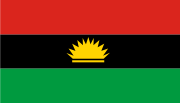 Biafra
Biafra Brazil
Brazil Chile
Chile Colombia
Colombia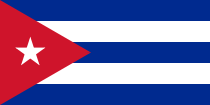 Cuba
Cuba Dominican Republic
Dominican Republic El Salvador
El Salvador France
France Guatemala
Guatemala Indonesia
Indonesia Nicaragua
Nicaragua Peru
Peru Portugal
Portugal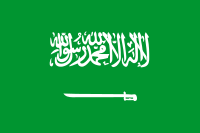 Saudi Arabia
Saudi Arabia South Vietnam
South Vietnam Turkey
Turkey United Kingdom
United Kingdom United States
United States
Survivors
Specifications (A-26B-15-DL Invader)


Data from McDonnell Douglas Aircraft Since 1920[3]
General characteristics
- Crew: 3
- Length: 50 ft 0 in (15.24 m)
- Wingspan: 70 ft 0 in (21.34 m)
- Height: 18 ft 3 in (5.64 m)
- Wing area: 540 ft² (50 m²)
- Empty weight: 22,850 lb (10,365 kg)
- Loaded weight: 27,600 lb (12,519 kg)
- Max takeoff weight: 35,000 lb (15,900 kg)
- Powerplant: 2× Pratt & Whitney R-2800-27 "Double Wasp" radials, 2,000 hp (1,500 kW) each
Performance
- Maximum speed: 355 mph (308 knots, 570 km/h)
- Range: 1,400 mi (1,200 nm, 2,300 km)
- Service ceiling 22,000 ft (6,700 m)
- Rate of climb: 1,250 ft/min (6.4 m/s)
- Wing loading: 51 lb/ft² (250 kg/m²)
- Power/mass: 0.145 hp/lb (108 W/kg)
Armament
- Guns:
- 6× 0.50 in (12.7 mm) M2 Browning machine guns in the nose
- 8× 0.50 in M2 machine guns in four optional underwing pods
- 2× 0.50 in M2 machine guns in remote-controlled dorsal turret
- 2× 0.50 in M2 machine guns in remote-controlled ventral turret
- Bombs: 6,000 lb (2,700 kg) - 4,000 lb in the bomb bay plus 2,000 lb external on the wings
Popular culture
- Two B-26 airtankers (No. 57- N9425Z and No. 59 - N4818E) were prominently featured in the 1989 Steven Spielberg film, Always.[33] The flying for the movie was performed by well-known movie pilot Steve Hinton[34] and Dennis Lynch,[35] the owner of the A-26s.
See also
- Water bomber
- SHORAN
Related development
Comparable aircraft
- Bristol Brigand
- Junkers Ju 388
Related lists
- List of military aircraft of the United States
- List of attack aircraft
- List of bomber aircraft
References
Notes
- ↑ Winchester 2004, p.74.
- ↑ Knaack, Marcelle Size. Encyclopedia of US Air Force Aircraft and Missile Systems: Volume 1 Post-World War II Fighters 1945-1973. Washington, DC: Office of Air Force History, 1978. ISBN 0-912799-59-5.
- ↑ 3.0 3.1 Francillon 1979
- ↑ Mesko 1980, p. 5.
- ↑ Winchester 2004, p. 75.
- ↑ 6.0 6.1 6.2 6.3 Thompson 2002
- ↑ Johnsen 1999
- ↑ 1999 kensmen.com, "June 1944" (43rd Bomb Group Association website) Retrived: 2 August 2007.
- ↑ Horne 1984, p.50.
- ↑ Francillion 1978, p.228.
- ↑ Military.CZ A-26
- ↑ Dorr and Bishop 1996, pp. 8-10.
- ↑ Troung, Albert Grandolini and Tom Cooper. Laos, 1948-1989; Part 1, 13 November 2003. Retrieved: 6 November 2007.
- ↑ 14.0 14.1 Smith 1966, p. 7.
- ↑ Smith 1966. p. 6.
- ↑ Mesko 1987, pp. 26–28.
- ↑ Volume I Operation Shed Light Study Report, 1966. pp. 1C-55, 59.
- ↑ Prados, John. President's Secret Wars. New York: William Morrow, 1986. ISBN 0-688-05384-X.
- ↑ Wyden, Peter. "Bay of Pigs: The Untold Story". New York: Simon and Schuster, 1979. ISBN 0-671-24006-4.
- ↑ "CIA Documents Confirm U.S. Deaths at Bay of Pigs" Los Angeles Times, March 17, 1998.
- ↑ Hagedorn and Hellström 1994
- ↑ Francillion 1978, p.217.
- ↑ Baugher, Joe. "A-26B Invader." USAAC/USAAF/USAF Bomber Aircraft. Retrieved: 29 June 2008.
- ↑ Baugher, Joe. "A-26C Invader." USAAC/USAAF/USAF Bomber Aircraft. Retrieved: 29 June 2008.
- ↑ 25.0 25.1 Mesko 1997, p. 18.
- ↑ According to a "Wings" (Discovery Channel) documentary, the B-26 was redesignated the A-26, because Thailand would not allow bombers to fly from their airfields, but they would allow attack aircraft to do so.
- ↑ USAF B-26K Factsheet
- ↑ Baugher, Joe. Invader in Service with L'Armee de l'Air. USAAC/USAAF/USAF Bomber Aircraft, 26 August 2006. Retrieved: 7 November 2007.
- ↑ Francillon 1978, p. 233.
- ↑ 30.0 30.1 30.2 Grinsell 1974, p. 44.
- ↑ Francillon 1978, p. 234.
- ↑ Douglas A-26 Invader
- ↑ Farmer, James H. "The Making of Always." Air Classics, Volume 26, No. 2, February 1990.
- ↑ Filmography - Steve Hinton. IMDB [1] Retrieved: 13 March 2007.
- ↑ Filmography - Dennis Lynch. IMDB. Retrieved: 13 March 2007.
Bibliography
- Dorr, Robert F. and Bishop, Chris.Vietnam Air War Debrief. London:Aerospace Publishing, 1996. ISBN 1 874023 78 6.
- Francillon, René. "The Douglas Invader Story". Air Enthusiast, Number Seven, July-September 1978. Bromley, Kent, UK: Pilot Press Ltd., 1978. pp.215—234.
- Francillon, René. McDonnell Douglas Aircraft Since 1920: Volume I. London: Putnam, 1979. ISBN 0-87021-428-4.
- Gallemi, Francis. A-26B/C Invader (Warbird Profile 1). Vaudreuil, Quebec, Canada: Aries Publications, 1994. ISBN 1-84176-080-3.
- Grinsell, Bob. "Invader." Wings Vol. 4, No. 3, June 1974.
- Hagedorn, Dan. Central American and Caribbean Air Forces. Staplefield, West Sussex, UK: Air Britain Historians Ltd., 1993. ISBN 0-85130-210-6.
- Hagedorn, Dan and Leif Hellström. Foreign Invaders, the Douglas invader in Foreign Military and US Clandestine Service. Earl Shilton, Leicester, UK: Midland Publishing, 1994. ISBN 1-85780-013-3.
- Horne, John E. "Douglas B-26s In Korea". Air Enthusiast, Number 24, April—July 1984. Bromley, Kent UK:Pilot Press. pp.50—59.
- Johnsen, Frederick A. Douglas A-26 Invader. North Branch, Minnesota: Specialty Press, 1999. ISBN 1-58007-016-7.
- Mesko, Jim. A-26 Invader in Action (Aircraft Number 37). Carrollton, Texas: Squadron/Signal Publications, 1980. ISBN 0-89747-093-1.
- A-26 Invader in Action (Aircraft Number 134). Carrollton, Texas: Squadron/Signal Publications, 1993. ISBN 0-89747-296-9.
- VNAF, South Vietnamese Air Force 1945-1975. Carrollton, Texas: Squadron/Signal Publications, 1987. ISBN 0-89747-193-8.
- Mikesh, Robert C. "Flying the Invader: Pilot Notes for the Douglas A-26". Air Enthusiast, Number Seven. July-September 1978. Bromley, Kent, UK: Pilot Press Ltd., 1978.pp.234—236.
- Smith, Mark E. USAF Reconnaissance in South East Asia (1961-66). San Francisco: Headquarters, Pacific Air Force, Department of the Air Force, 1966.
- Thompson, Scott. Douglas A-26 and B-26 Invader. Ramsbury, Marlborough, Wiltshire, UK: Crowood Press Ltd., 2002. ISBN 1-86126-503-4.
- Thompson, Warren. B-26 Invader Units over Korea. Botley, UK: Osprey Publishing, 2000. ISBN 1-84176-080-3.
- Volume I Operation Shed Light Study Report. Washington, DC: Headquarters, DCS Research and Development, Headquarters, United States Air Force, 1966.
- Winchester, Jim. "Douglas A-26 Invader." Aircraft of World War II. London: Grange Books, 2004. ISBN 1-84013-639-1.
External links
- National Museum of the USAF: Fact Sheets : Mid-World War II Attack Aircraft
- Hill Aerospace Museum: Douglas A-26 "Invader" Information
- AirForceHistory: B-26 Bomber, Martin or Douglas?
- A Date with Danger, Airman, May 2001
- Hurlburt AFB: Fact Sheets: A-26 Counter-Invader
- Hurlburt AFB: A-26 Counter-Invader
- A-26 Lady Liberty - Confederate Air Force
- The A-26 Legacy Foundation: Operation Final Flight
|
|||||
|
|||||
|
|||||
|
||||||||
|
||||||||||||||